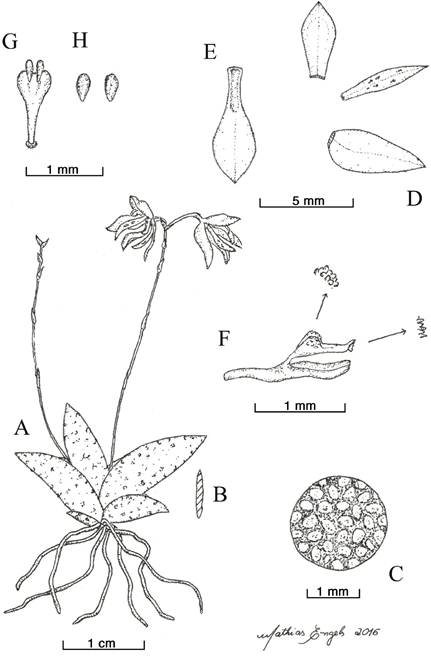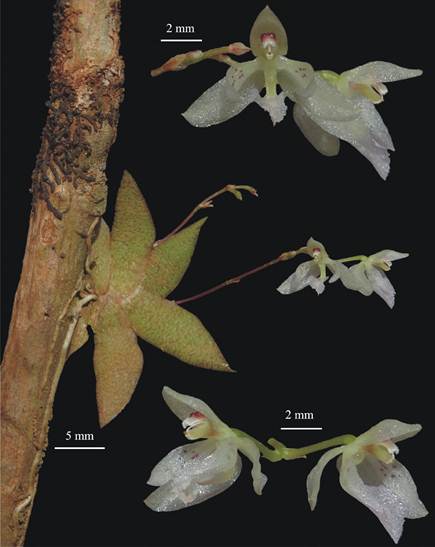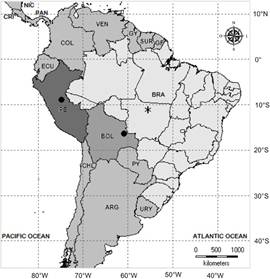Introdution
The neotropical genus Macroclinium Barb.Rodr. is constituted by 44 species (Govaerts 2016), found from Mexico to Bolivia and Brazil (Pupulin 1997). Six species had been previously recorded from Brazil: Macroclinium brasiliense (Pabst) Dodson, M. mirabile (C.Schweinf.) Dodson, M. paraense Campacci & da Silva, M. roseum Barb. Rodr., M. saraca-taquerense Campacci & da Siva, and M. wullschlaegelianum (Focke) Dodson. The species are distributed in the states of Amazonas, Goiás, Maranhão, Pará, Rio de Janeiro, Rondônia, Roraima, Tocantins and in Distrito Federal (BFG 2015, Campacci et al. 2015).
During the flora rescue at the Hydroeletric Power Plant of Colíder (Mato Grosso State), material of Macroclinium chasei Dodson & Benn. was collected, corresponding to a new record for Brazil. The species is here presented with a description, illustration, photographs, as well as taxonomical and ecological comments.
Taxonomic Treatment
Macroclinium chasei Dodson & D.E.Benn., Icon. Pl. Trop., ser. 2, 1: t. 98 (1989).
TYPE: Peru. Huanuco: Leôncio Prado, 5-7 Km towards La Divisoria from Tingo Maria, 850 m, 20.VII.1987, L. Moore ex D. Bennett & M. Chase 4092 (holotype MO, illustration!).
Epiphytic herbs. Roots ca. 0.5 mm thick, terete, whitish. Stem compact, pseudobulbs absent. Leaves alternate and imbricate, 4-6 by sympodium, 0.7-1.4 × 0.4-0.5 cm, laterally compressed, falcate, slightly fleshy, apex acute to obtuse, green, with reticulate, brownish and thick ribs. Inflorescence axillar, biflowered, at beginning simple, becoming composed with the production of new secundary inflorescences; main peduncle 15-33 mm long, 0.25 mm thick, terete, brown to greenish; secundary peduncle 2-3 mm long, 0.25 mm thick, terete, brown to greenish. Flowers resupinates. Ovary and pedicel ca. 4 mm long, 0.3 mm in diameter, terete, pale green. Dorsal sepal ca. 4 × 2 mm, elliptic to elliptic-oblanceolate, obtuse to acute, white. Lateral sepals ca. 5.0 × 2.0-2.5 mm, lanceolate-ovate, obtuse, white. Petals ca. 4 × 1 mm, narrowly elliptic, acute, white with purple-pink dots. Lip 5.0-6.0 × 1.5-2.0 mm, unguiculate, white to white slightly pink; claw adaxially sub-canaliculate; blade elliptic to elliptic-oblanceolate, acute to obtuse, the margin sometimes slightly ondulate. Column ca. 1.5 mm long, clinandrium minutely denticulate, white with base purple-pink. Anther ca. 0.6 mm long, purple-pink. Pollinia 2, ca. 0.3 mm, ovate, laterally dorsifixed, subovate, with two globoses protuberances flattened, yellow; stipe ca. 1 mm long, subspathulate, at the base, these with inconspicuously alveolate translucid-white; viscidium ca. 0.1 mm long, rounded, surface, apex minutely denticulate, white with base white-brownish. Fruits and seeds not seen.

Figure 1 Macroclinium chasei. A. Habit. B. Section of leaf. C. Detail of texture of the leaf. D. Perianth flattened. E. Lip flattened. F. Column with anther. G. Pollinarium. H. Pollinia in lateral view. Illustration by M.E.Engels based on Engels & Bezerra 4773, MBM.

Figure 2 Macroclinium chasei. Habit and flowers (Engels & Bezerra 4773, MBM). Photographs by M.E. Engels.
Examined Material. Brazil. Mato Grosso: Itaúba, Flora Macroclinium chasei occurs in Bolivia, Peru rescue from UHE Colíder, fl., 21 July 2016, M.E. (Bennet & Christenson 1994, Pupulin 1997, Carnevali Engels & A.S. Bezerra 4773 (MBM, RB, TANG - & Cetzal-Ix 2012, Govaerts 2016) and Brazil, in the spirit collection). Fig. 1-3. Mato Grosso State (Fig. 3). This material correspond to the first record of the species in Brazil. It was found as an epiphyte of thin branches in the canopy in the paludose forest (Stational Forest Always Green Aluvial) crossed by a tributary stream of the Teles Pires river, in southern Amazonia. Flowering occurs from July to October.

Figure 3 Distribution map of Macroclinium chasei. Circle: previous records. Asterisk: current record.
We believe that this species may occur in other areas of the Brazilian southern Amazonian that share the same ecological and phytophysiognomics conditions. According to Miranda and Menini Neto (2010) several orchids are seldom collected because they are rare, occur in places with difficult access (in this case, trees canopy) and are not easily seen during collect expeditions due to their small size. This facts may explain the lack of records of Macroclinium chasei in Brazil until now.
Macroclinium chasei belongs to M. sect. Hirtzae Dodson & Pupulin, a group characterized by plants without pseudobulbs, non-articulated leaves, biflowered inflorescences, column with thickened apex, dorsal anther, opercule fixed at base of clinandrium, and discoid and flat pollinia (Pupulin 2001). In addition to M. chasei, other species belonging to this section are M. biflorum Bennet & Christenson, M. brasiliense, M. dentiferum Thiv, M. hirtzii Dodson, M. mirabile, M. paraense and M. saraca-taquerense. Besides M. chasei, other four species of M. sect. Hirtzae occur in Brazil: M. brasiliense, M. mirabile, M. paraense and M. saraca-taquerense. It differs from these by the entire lip, acute to obtuse apex, without callous and by the apex of the clinandrium and anter minutely denticulate.
The leaf surface of M. chasei presents thick and brown reticulations over the green blade (Dodson & Bennet 1989), a texture that is more evident in individuals living in places with higher exposition to the sun light.
Conservation - Data Deficient (DD): known only from one collect in Brazil, lack of additional individuals from the site and neighboring regions (IUCN 2010).












 uBio
uBio 

